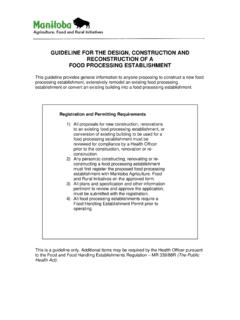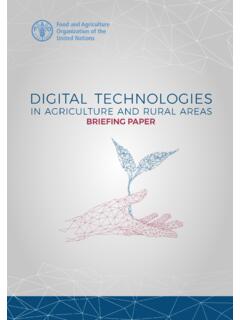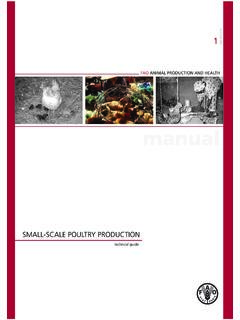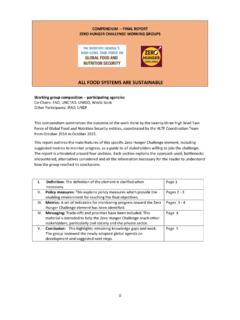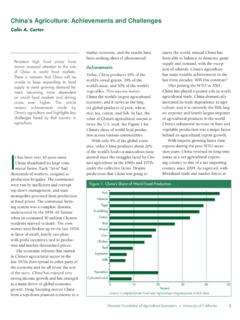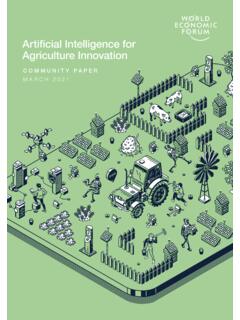Transcription of Agriculture and Green Growth - OECD
1 1 Agriculture and Green Growth Candice Stevens* *Former OECD Sustainable Development Advisor 2 Agriculture AND Green Growth Candice Stevens TABLE OF CONTENTS INTRODUCTION: THE Green Growth PARADIGM THE IMPLICATIONS OF Green Growth FOR Agriculture A. Agricultural contributions to Green Growth B. Green Growth contributions to Agriculture POLICY TOOLKIT FOR Green Growth IN Agriculture A. Regulations and standards B. Support measures C. Economic instruments D. Trade measures E. Research and development F. Development assistance ADDRESSING ENVIRONMENTAL CHALLENGES IN Agriculture A. Climate change B. Water management C. Land management D. Biodiversity loss E. Biomass production POLICY CONSIDERATIONS: USING THE Green Growth POLICY TOOLKIT EFFECTIVELY A.
2 Impact assessments B. Environmental cross-compliance mechanisms C. Structural adjustment measures D. Solutions for alternative farm systems MEASURING PROGRESS ON Green Growth IN Agriculture REFERENCES 3 INTRODUCTION: THE Green Growth PARADIGM The OECD will deliver a Green Growth Strategy Synthesis Report to the 2011 Ministerial Council Meeting which will also provide the basis for an OECD contribution in 2012 to Rio+20, an international conference on sustainable development. The OECD Green Growth Strategy will elaborate tools and recommendations to aid governments in identifying the policies that can help achieve the most efficient shift to environmentally-sound Growth . This report on Agriculture and Green Growth explains the significance of greener Growth for the agricultural sector, elaborates a policy toolkit for Green Growth in Agriculture , and discusses important considerations in addressing specific environmental challenges in Agriculture .
3 The emergence of the concept of Green Growth marks a shift in the paradigm for economic progress to an approach which emphasizes environmentally sustainable development (Table 1). Traditional economic models have tended to treat environmental protection as an economic burden which detracts from or slows Growth . The Green Growth model recognizes that steps to protect and conserve environmental resources can be a driver for national and global economic progress. Future economic Growth will itself be put at risk if the Green Growth paradigm is not put in place. The principle obstacle to Green Growth is not an inherent tension between economic and natural systems, but the political economy of change and the need to address the environmental consequences of current economic development patterns.
4 Table 1: Traditional Economic vs. Green Growth Policy Paradigm Traditional Economic Paradigm Green Growth Paradigm Economic-environment links Environmental protection viewed as detracting from economic Growth Environmental protection viewed as a driver of economic Growth Planning perspective Short- to medium-term perspective Long-term perspective Policy perspective Government policy interventions to correct overt market failures Government policy interventions to promote structural changes and facilitate adjustment Scope of environmental responsibility Government agencies and private sector units responsible for environmental management All government agencies, corporate departments and wider society Environmental policy interventions Improvements to existing modalities of consumption and production Changes to patterns of economic activity to reduce environmental pressures Economic policy interventions Taxes and charges on environmental externalities Supports and fiscal incentives to Green innovation, activities, businesses and jobs Economic indicators Measure rate and level of economic Growth , GDP.
5 Productivity Measure qualitative aspects of Growth or well-being including environmental quality Environmental indicators Measure resource use and output of pollutants Measure linkages between economic activity and output of environmental goods and services 4 The realization of Green Growth depends on policies which spur economic development and job creation which devise value-added from the environment. This requires longer-term policy perspectives rather than the current stress on short and medium-term results as well as adjustment strategies to manage the successful transition to low-carbon, resource-efficient economies. Green Growth also demands policy coherence across economic, environmental and sector interventions. A broad range of government and corporate departments should be involved in implementing Green Growth policies and approaches rather than stand-alone environmental agencies or business units.
6 A primary conceptual change in the Green Growth policy paradigm is the need to transform production and consumption patterns from resource intensive processes to eco-efficient and low-carbon trajectories. Current OECD environmental policies have been relatively successful in addressing pollution, including through end-of-pipe and more integrated processes, and encouraging the adoption of life-cycle perspectives. However, more efforts are needed to alter fundamental patterns of economic activity in order to decouple Growth from environmental degradation and to support the expansion of commercial eco-industries and eco-services. In developing countries, realizing significant gains in material living standards without imposing excessive burdens on environmental carrying capacity is the primary goal.
7 Green Growth is a concept that brings together a suite of policies to promote a transformation of consumption behavior, industry structures and technologies. This involves regulatory and fiscal measures to reduce the energy and carbon intensity as well as the land and water intensity of production and consumption in all sectors. Green Growth policies also seek to stimulate investments and steer spending towards clean technologies, renewable energy, water services, Green transportation and infrastructure, waste management, and bio-based businesses. In the Green Growth paradigm, traditional economic and environmental measures of progress are replaced by indicators of the linkages between the use of environmental goods and services and economic Growth .
8 Green Growth calls for a focus on qualitative Growth rather than measuring success based on traditional economic indicators such as gross domestic product (GDP) or economic productivity. Interrelated indicators of economic progress, environmental sustainability and social welfare are needed. In Agriculture and other sectors, progress on Green Growth is measured by the ability to contribute to social well-being by providing sufficient goods and services in ways that are economically efficient and environmentally beneficial. 5 THE IMPLICATIONS OF Green Growth FOR Agriculture Moving towards greener Growth in the agricultural sector will involve both synergies and trade-offs which will change over time. The implications of Green Growth for Agriculture and the contributions of Agriculture to Green Growth can be reciprocal or incongruent.
9 Table 2 gives a broad view of the possible synergistic and conflicting effects of Green Growth on Agriculture across and within the different pillars of sustainability: economic, environmental and social. In the cells on the main diagonal, the two perspectives are mutually reinforcing as indicated in the positive sign. Policy pairs below the main diagonal may work against each other particularly in the short-term (negative sign), while paired interventions above the main diagonal are mutually enhancing (positive sign). In the short-term, Green Growth policies which place a premium on environmental protection may constrain agricultural output, reduce global food security and entail adjustments in the use of human, financial and natural resources.
10 The implications of Green Growth for Agriculture in the longer-term are mutually-reinforcing in terms of environmental sustainability, economic Growth and social well-being. The complementarities and differences between Green Growth and Agriculture are reviewed in more detail below in terms of traditional economic factors ( productivity, farm incomes, employment) and environmental factors ( natural resource use, pollution, biodiversity) as well as broader social factors ( food security, poverty reduction, rural development). While this report discusses Green Growth with a focus on primary Agriculture , there is a much longer agro- food supply chain including processing and distribution which has Green Growth implications. The end results will depend on the policy instruments adopted and the structural adjustment measures which are put in place to ease the transition to a greener agricultural sector.










